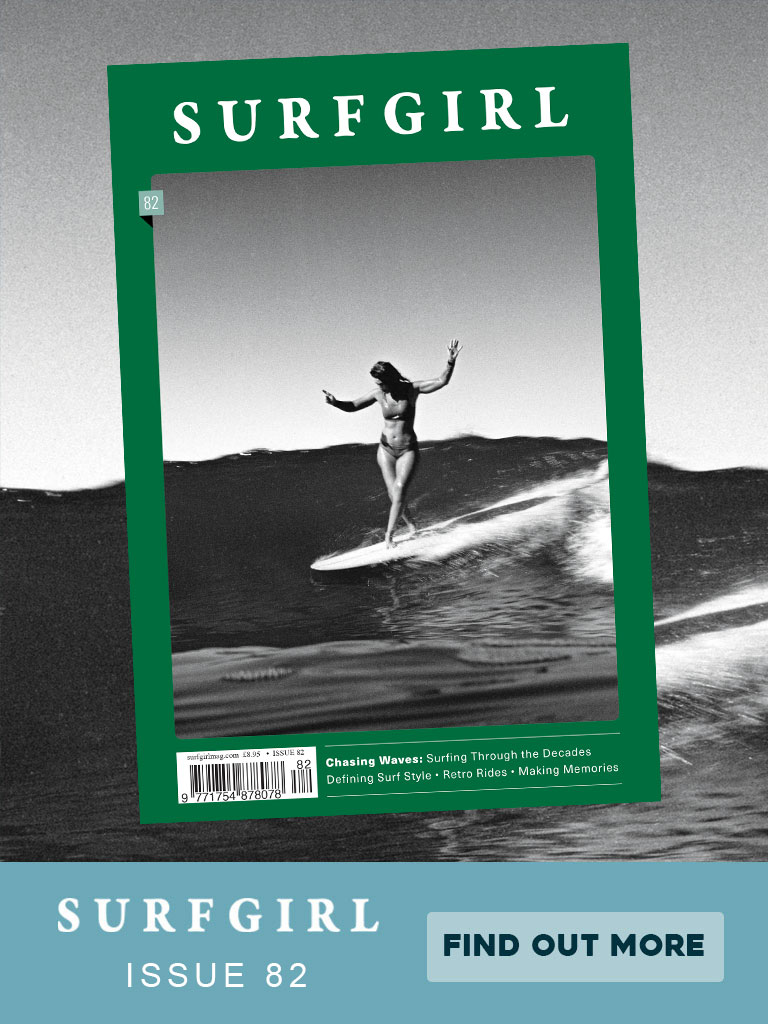Length, width and thicknessThese are measured at the greatest parts of the board – the longest, widest and deepest points. One of the most important things to remember when getting your first, or maybe even second, board is DON’T GO TOO SMALL TOO SOON. Volume is king when learning to surf, especially after childhood has left us. If you go shorter, make sure you get plenty of width and volume – the bigger the board, the more waves you’ll get, and more waves means more fun! |

NoseWhile a pointy stick is less likely to nosedive and creates a longer curve on the rail, it doesn’t help in catching waves. Great on steep, fast waves, it’s not the ideal shape if waves are smaller or the surfer is a little wobbly. A rounded point, or completely round nose, offers volume, which is great for stability and also very important for catching waves (especially for us girls). Lacking the upper-body strength of our male counterparts (who until quite recently most boards were designed for), it’s advantageous for us to have more volume at the front of the board. So, a nice big honker is better. It’ll teach you good technique for turning using your fins too. |
TailThere are the four main types of tail you’re going to come across, with the round-tail being an ideal shape while you’re still learning to take control. Water moves in the path of least resistance, so the tail is important; not just when giving you direction as water is released at the end of your board, but to provide drive to move you forward over the water. Wider tails, such as the round or fish designs, allow for more water underneath them, pushing you forward and enabling more stable turns. They are also fantastic in smaller surf, unlike a squash or pin-tail (favoured by shortboards) that allows water to move away from the board quickly, making it looser and snappier to turn. The pin tail offers control on bigger waves and lovely carving potential, but neither give much in the way of lift, making them less suited to learners. |

RailsRails are all about turning. Look at the profile of your board. Pointy short boards with tucked-in tails have a large arch that is optimal for making clean, smooth turns. Longer boards, especially with large, rounded noses, are much straighter – which makes holding your line in the water much easier and gives a stable ride to get up on and learn to make turns. It might seem that if a board is designed to make turning easy, then it’ll be easy to learn to turn on. Sadly, this is not the case. With surfing there is no cutting corners and most of us simply learn to turn slowly and steadily on a big board with straight rails, before even dreaming of staying on a board while whipping round and making spray. But this is not all there is to rail technology. These 3D curved lines go round as well, that is if they’re not going square. |
RockerWhen learning, the rocker of the board you choose is not to be ignored. Turn a board sideways or lift one end of it, looking straight down its belly, and you’ll see the curve of the underside of the board: this is its rocker. When we talk about a board having a lot of rocker, what we mean is that it is very curved underneath, like a banana. In small waves, or for the unstable surfer, less rocker means more of the board is in contact with the water, which is great. For those who can generate speed all on their own and want to flick their board around in tight turns, lots of rocker, so lots of board coming out of the water, will allow them to do so. All boards have some rocker though, and there is a difference between having it in the tail and the nose. Nose rocker will make your board less prone to nose-diving. Tail rocker can do the same, by allowing more room for you to bring your weight back and the nose out or the water. More tail in the water creates more drive and speed for you, especially in smaller swells. It’s a balance, but if you go for less rocker while learning, you will later be able to rely on your technique being solid. |
ShapeThere are so many shapes and sizes of boards out there, so lets just take a look at some classic step-ups or intermediate fun boards. |
 |
 |
 |
THE MINI-MALEasily one of the most popular intermediate surfboards that many can happily say they have learnt on. With a big nose, round tail and plenty of volume, these boards are a step down from the foamy or longboard. They are less cumbersome to manoeuvre, but still make catching waves easy and fun for surfers of all levels. I have still never parted with mine as it’s fun to dig out on small days. |
THE EGG or MAGIC CARPETThis lovely design (probably originally credited to Nineplus) is essentially a longboard with the middle cut out. Usually these boards have very wide noses, often with a more tapered tail. This makes catching waves easy and encourages rail-to-rail turns, helping with learning to look more controlled and stylish in the water! |
THE FISHFun to ride, the rounded-point nose helps when learning to handle slightly steeper take-offs, while the overall profile has heaps of volume and a tail that turns. The great thing about fish is that they range from tiny 5-footers, right up to lengthy 6-foot somethings, while still keeping high volume with width and thickness. They are easily movable in the water, stable in smaller surf and are fast for paddling into waves. |


